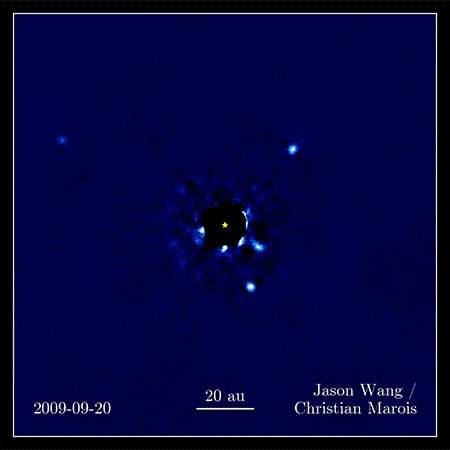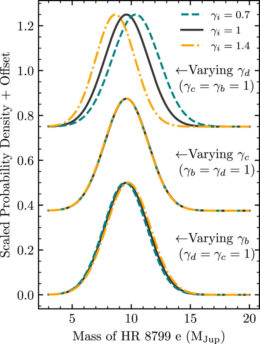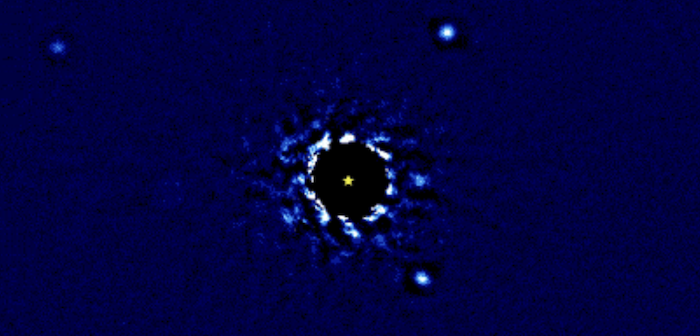Editor’s note: Astrobites is a graduate-student-run organization that digests astrophysical literature for undergraduate students. As part of the partnership between the AAS and astrobites, we occasionally repost astrobites content here at AAS Nova. We hope you enjoy this post from astrobites; the original can be viewed at astrobites.org.
Title: The First Dynamical Mass Measurement in the HR 8799 System
Authors: G. Mirek Brandt et al.
First Author’s Institution: University of California, Santa Barbara
Status: Published in ApJL
Astronomers have caught the first directly imaged exoplanet gravitationally tugging at its host star — thereby revealing its own weight.
Did you know that we can now take pictures of planets orbiting another star hundreds of light-years away? The HR 8799 system is famous for hosting one of the first directly imaged exoplanets. The four imaged planets are giants with masses greater than 5 times the mass of Jupiter (MJup) and wide orbits. They are named planet e, d, c, and b in order of proximity to the star. In the 13 years since their first detection back in 2008 by the Keck and Gemini telescopes in Hawaii, astronomers have tracked the planets’ orbital motions around HR 8799 with great precision (Figure 1).
This has enabled the authors of today’s article to calculate the mass of an exoplanet in this system using simple dynamics such as Newton’s and Kepler’s laws of motion. In particular, they concentrate on planet e, the one closest to HR 8799.

Figure 1: The HR 8799 planetary system. Blocking out the light from the central star allows us to observe and track the motions of four of its exoplanets. The given scale of 20 au, a little more than the orbit of the first planet (planet e), is equal to the distance between the Sun and Uranus. [Christian Marois (Herzberg Institute of Astrophysics) and Jason Wang (University of California, Berkeley)]
Precision Astrometry as a Weighing Scale
The measurement of planet e’s mass rides on the fact that the motion of the four planets produces minute tugs on host star HR 8799, thereby changing the star’s position in the sky ever so slightly. The process of making extremely precise measurements of a star’s sky coordinates is known as astrometry, a technique that has become especially prominent in recent years with new sky surveys like Gaia complementing their predecessor Hipparcos. The researchers used data from Gaia’s latest data release (DR3) to track the acceleration of HR 8799 caused by the net gravitational forces of all four planets.
Knowing the masses of all four major planets accurately makes it possible to predict how much they can accelerate HR 8799. In turn, precise observations of the star’s acceleration enabled the researchers to reverse this calculation and infer the exoplanet masses.

Figure 2: The inferred probability distribution of the mass of planet e, based on varying the assumed mass ratios of other planets with respect to it (top: d, middle: c, bottom: b). The top panel shows that planet e’s mass estimation is most sensitive to the second-closest planet, planet d, being heavier (yellow curve) or lighter (teal curve). It does not depend much on the relative weights of the farther two planets. [Brandt et al. 2021]
How Heavy Is Planet e?
As the closest planet to HR 8799, planet e plays the principal role in shaking up its host star. However, the contributions from the other planets in the system are needed to determine how prominent planet e’s tugs are, and in turn how heavy the planet may be. Without knowledge of any of the planets’ masses, it is necessary to make assumptions about how much they weigh relative to each other. Figure 2 shows the authors’ best estimates for planet e’s mass, shown as probability distributions assuming different ratios of its mass to the masses of the other planets in the system.
The authors determine the resulting mass of planet e to be 9.6 times that of Jupiter, within an error bound of 2 MJup. They can say with a 95% certainty that its mass is below 13 MJup, above which it would have enough pressure at its core to start fusing deuterium and trigger nuclear fusion to become a (proto)star itself!
Implications for the Stellar System
In spite of being the planet closest to HR 8799, planet e is still three times farther away than Jupiter is from the Sun. Are there any smaller planets in the HR 8799 system, closer to the star than planet e but small enough to escape detection via direct imaging?

Figure 3: Can a hypothetical planet with a certain mass (y-axis) exist within the 16 au distance (x-axis) between HR 8799 and the orbit of planet e? The purple region represents heavier masses that are excluded since their effect is not seen in observations. [Brandt et al. 2021]
This study is a marker for how far we have come in studying exoplanets. It is a fine example of applying simple dynamics to study the gravitational dance and motions of an exoplanetary system — techniques that, until recent times, could only be applied to study our own solar system.
Original astrobite edited by Olivia Cooper.
About the author, Sumeet Kulkarni:
I’m a third-year PhD candidate at the University of Mississippi. My research revolves around various aspects of gravitational-wave astrophysics as well as noise characterization of the LIGO detectors. It involves a lot of coding, and I like to keep tapping my fingers on a keyboard even in my spare time, creating tunes instead of bugs. I run a science cafe featuring monthly public talks for the local community here in Oxford, MS, and I also love writing popular science articles. My other interests include reading, cooking, cats, and coffee.

